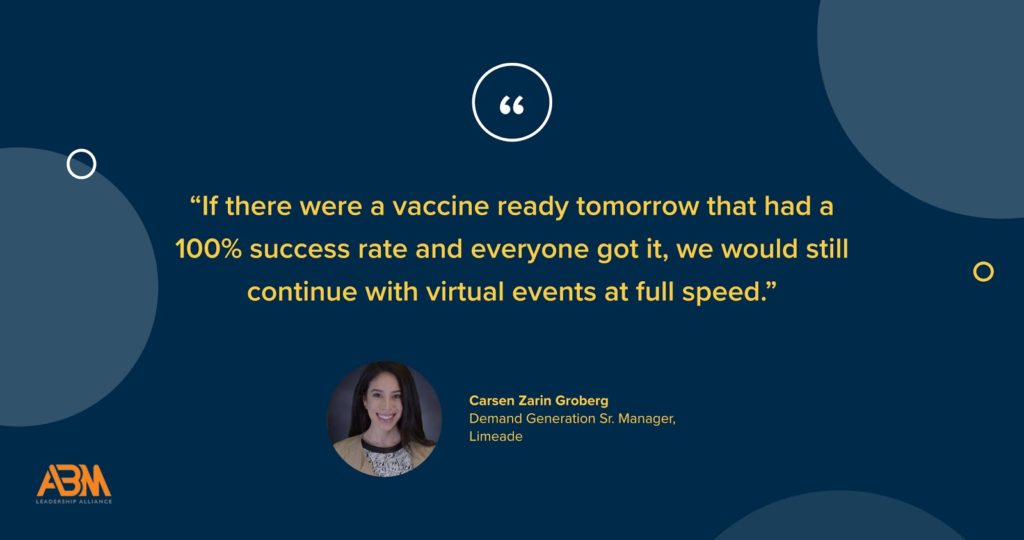This 7th Annual Benchmark Study, developed by ITSMA and the ABM Leadership Alliance, provides an essential review of the current state of play with Account-Based Marketing.
ebook

This article is part of the ABM Now series where we explore how ABM has changed in 2020. What will you take with you? What will you leave behind? Read the whole series here.
This fall, a Halloween-themed postcard arrived in the mail at a Michigan residence. This probably would not have taken social media by storm had it not carried a curious 1-cent stamp and a surprising send date—1920. The postcard took 100 years to arrive.
As the story zipped across social media, I kept seeing the same comments over and over—“Nobody mails things anymore” and “I miss receiving things.” It touched on something I feel my two interviewees today and hundreds of thrilled recipients of ABM gift boxes on LinkedIn and Twitter know well: In a digital world, tactile experiences rule, even if they’re a little delayed.
I sat down with Carsen Zarin Groberg, Demand Generation Sr. Manager at Limeade, and Samantha Yarborough, Director of Strategic Partnerships at PFL, to ask, “What has this year been like for you?” Beyond feeling like January was 100 years ago, here’s what they shared.
Carsen Zarin Groberg
I work on the Experiential Team, which in other companies, might be considered something like the Event Marketing Team. We handle all experiences, whether online, in the field, or in your mailbox, and that’s fitting because what Limeade offers is an elevated employee experience for large organizations across the globe.
Going into this year we had 25 webinars and 40 in-person events planned. We had an event for every single week of the year and were looking forward to a lot of the meaningful, high-touch interactions that are so important to our ABM account strategy.
When the pandemic hit, I had only been an employee of Limeade for five months but was immediately proud to be on a team that could turn on a dime to make things happen. My team is used to saying, “Who needs help? I’ve got you,” and “We need to rotate in another direction—let’s go.”
Though our original goal was to host 25 webinars in 2020, we’re on track to complete 52 this year and have generated the same number of meetings we’d planned to. Our generation is 131% over this time last year and the amount of qualified leads is 200% over. Our inquiries are hovering at 450%. Though it’s certainly not accurate to say the Experiential Team is responsible for all of that success, I do believe we did some things fundamentally right, like capitalizing on virtual events.
Samantha Yarborough
Very similar to Carsen, we had so many events on the calendar, and in-person was intrinsic to our go-to-market strategy. Our marketing team had even produced a “PFL in Concert” shirt with all the cities we were going to. In-person was core to how we built relationships and networked. Paired with direct mail, that was a significant part of our plan. Then in March, the plug got pulled, and everyone had to pause and rethink.
Experiences have taken on a whole new meaning. Things have gone heavily to webinars, everyone’s now very familiar with Zoom, and people are facing virtual event fatigue. It’s got us asking, “How do we offer experiences that are truly adding value, not just noise?”
Carsen
Direct mail is one of the most successful lead generation channels at Limeade. But like so many companies, we came to a screeching halt with our direct mail in early spring. People were avoiding touching packages and disinfecting their groceries. Shutting the program down was dangerous for us, and we immediately worked with PFL to launch a virtual version of our direct mail campaign that allowed us to continue sending via email, and to run tests.
One of my favorite learnings was that people care. We ran an A/B test where one group received an UberEats gift card with a nice note about buying themselves dinner from a local restaurant. The other group received a gift card that they could donate to a charity of their choice. Practically nobody who received the UberEats gift card responded. Nearly all of those who got the charity gift card did.
If I were to paint with a broad brush, I think that in a time of panic, most Americans were already acting out of self-care. Recall that not long ago, we were all hoarding toilet paper. But everyone had a latent desire to give back and when we gave them that opportunity, we awakened something and created a moment of connection. Despite the fact there was no real ask, it generated meetings.
Then, the mail resumed. The fear of packages subsided, people were more and more willing to give us their home addresses, and we could resume our campaigns.
Samantha
At PFL, we of course specialize in direct mail, so we saw the pause in mail up-close. Our customers pushed the pause button, and so did we. Our outbound BDR sequences are heavy on direct mail, but there was the health concern plus people were no longer going into the office, which is where we had their contact information. We didn’t want packages piling up on desks.
We promptly switched to call and email sequences. Our response and booked meeting rates plummeted. Time passed, we started to move through the pandemic, and it became clear we would all be working from home indefinitely. People started to realize they wouldn’t get sick from picking up a package on the porch.
We worked directly with FedEx to ensure things were safe and when we resumed sending, we saw a 10x increase in booked meetings. Then the question was, “Are people going to be comfortable giving out their home address?” To our surprise, they were.
We created landing pages for customers to collect people’s preferred addresses and were very upfront and honest—we still want to communicate with you and send you something. Where would you like us to send it? We found that 22% of people who did provide their home address ended up booking a meeting.
Samantha
HubSpot recently released a study on digital noise. The baseline for the volume of noise was already ridiculous, and then in March, it was just over the top. Lots of us can agree that our inboxes are basically trash collectors at this point. And if we can’t have face-to-face experiences, there’s direct mail, which has a 100% open rate and is fun and flattering. I mean, who doesn’t want to open a personalized package?
You can target direct mail just the same as any channel. With PFL, you can use demographic and intent data to inform the content and timing of your direct mail, making every prospect feel like your only prospect. For example, if you’re running a webinar, send registrants popcorn to increase their odds of showing up.
Carsen
My immediate answer is nothing, actually, and here’s why: Everything we did, right or wrong, was a lesson that I want to take with us. There are no mistakes, really, only choices, and we want to grow and continue adding tools to our toolbelt.
Samantha
Uh, how about all of 2020? Just kidding. I know one thing we’re questioning right now is, even if in-person events do come back, is that really where we want to put our resources? I think everybody’s proven that we can win without being on a plane every week, away from our families. If we can accomplish all that from a webinar, do we really need to go back to resource-intensive trade shows?
Carsen
If there were a vaccine ready tomorrow that had a 100% success rate and everyone got it, we would still continue with virtual events at full speed. They aren’t going anywhere for us now that we’ve established our presence. I think it comes down to the breadth and reach they offer versus in-person.
Samantha
To remain intentionally agile. To periodically put time on the calendar to ask ourselves, “Okay, this is working, but how can we make it better, not only for our customers but internally?” Because, who knows? In three-months time, it could all change again.


Sr. Director, Partner and Channel Marketing, Demandbase
Christine Farrier is the Senior Director of Partner Marketing at Demandbase. In this role, she brings together substantive marketing, communications and entrepreneurial expertise primarily focused in the investment banking and technology industries. Prior to joining Demandbase, Christine held marketing leadership roles with IHS Markit and Imagine Software and successfully exited from her arts and culture startup.

Demand Generation Sr. Manager, Limeade
Carsen Zarin Groberg is the Demand Generation Sr. Manager at Limeade (ASX: LME), an employee experience software company that helps build great places to work. Carsen works on experiences at Limeade to drive demand including webinars, virtual events, and direct mail campaigns. On a daily basis, Carsen is grateful for the amazing team she works with at Limeade—even if she only sees them through a computer screen.

Director of Strategic Partnerships, PFL
With nearly a decade of experience in marketing, branding, and design, Sam approaches her clients and customers with strategy, creativity, and results. Having been a customer, marketer, and now a Martech strategist, she has a unique ability to bring empathy and solutions to every part of your funnel. Calling on her background in advertising, Sam knows the best marketing strategies are timely, impactful, personalized, and result-oriented—building lasting rapport with your clients.